The following screen captures explain what can be seen in the panorama:
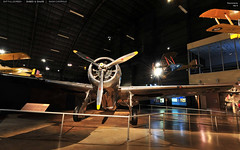 In 1934 North American Aviation developed the O-47 to replace the O-19 and O-38 observation biplanes. Larger and heavier than most preceding observation aircraft, its crew of three sat in tandem under the long canopy. Since the wings restricted downward observation and photography, North American put windows in the aircraft's deep belly.
In 1934 North American Aviation developed the O-47 to replace the O-19 and O-38 observation biplanes. Larger and heavier than most preceding observation aircraft, its crew of three sat in tandem under the long canopy. Since the wings restricted downward observation and photography, North American put windows in the aircraft's deep belly. When the United States entered World War I, plans called for American manufacturers to mass produce aircraft already in use by the Allies. One of the fighters chosen was the British Eberhart S.E.5A, designed by the Royal Aircraft Factory. Noted for its strength, stability and speed, the S.E.5A rivaled the Sopwith Camel as the most successful British fighter of WWI.
When the United States entered World War I, plans called for American manufacturers to mass produce aircraft already in use by the Allies. One of the fighters chosen was the British Eberhart S.E.5A, designed by the Royal Aircraft Factory. Noted for its strength, stability and speed, the S.E.5A rivaled the Sopwith Camel as the most successful British fighter of WWI.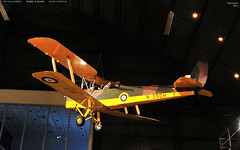 This classic British De Havilland DH 82A Tiger Moth trainer made its first flight on Oct. 26, 1931. It is one of a number of models of light aircraft named for moths, in recognition of designer Geoffrey de Havilland's interest in moths and butterflies. It became popular with air forces throughout the United Kingdom as well as the civilian aviation market.
This classic British De Havilland DH 82A Tiger Moth trainer made its first flight on Oct. 26, 1931. It is one of a number of models of light aircraft named for moths, in recognition of designer Geoffrey de Havilland's interest in moths and butterflies. It became popular with air forces throughout the United Kingdom as well as the civilian aviation market. From May to August 1941, Number 71 Squadron flew the Hawker Hurricane MkIIa aircraft. The Hawker Hurricane was one of the most famous British fighters of World War II. The Hurricane is probably best known for its performance during the Battle of Britain. When the Battle of Britain commenced in July 1940, the RAF Fighter Command had but 527 Hurricanes and 321 Spitfires to counter the enemy's 2,700 aircraft. Yet, the RAF was able to maintain air superiority in the skies of Great Britain.
From May to August 1941, Number 71 Squadron flew the Hawker Hurricane MkIIa aircraft. The Hawker Hurricane was one of the most famous British fighters of World War II. The Hurricane is probably best known for its performance during the Battle of Britain. When the Battle of Britain commenced in July 1940, the RAF Fighter Command had but 527 Hurricanes and 321 Spitfires to counter the enemy's 2,700 aircraft. Yet, the RAF was able to maintain air superiority in the skies of Great Britain.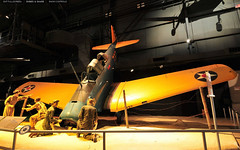 The North American NA-64, Army Air Corps designation BT-14, was a basic trainer developed by North American from its earlier BT-9. This exhibit demonstrates what could happen to a cadet pilot when taxiing with the wind from behind and applying his brakes too hard. The wind would lift the tail, and the nose would hit the ground. Such an accident resulted in at least a stern lecture from the instructor and possibly the student's dismissal from the school. On average during the war, 40 percent of the cadet pilots did not graduate from flying school.
The North American NA-64, Army Air Corps designation BT-14, was a basic trainer developed by North American from its earlier BT-9. This exhibit demonstrates what could happen to a cadet pilot when taxiing with the wind from behind and applying his brakes too hard. The wind would lift the tail, and the nose would hit the ground. Such an accident resulted in at least a stern lecture from the instructor and possibly the student's dismissal from the school. On average during the war, 40 percent of the cadet pilots did not graduate from flying school.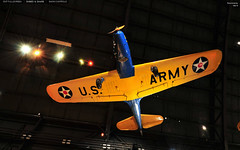 Fairchild developed the PT-19 in 1938 to satisfy a military requirement for a rugged monoplane primary trainer, and it went into quantity production in 1940. In addition to those manufactured by Fairchild, the Aeronca, Howard and St. Louis Aircraft Corps. produced Fairchild PT-19A Cornells. Fleet Aircraft Ltd. produced them in Canada.
Fairchild developed the PT-19 in 1938 to satisfy a military requirement for a rugged monoplane primary trainer, and it went into quantity production in 1940. In addition to those manufactured by Fairchild, the Aeronca, Howard and St. Louis Aircraft Corps. produced Fairchild PT-19A Cornells. Fleet Aircraft Ltd. produced them in Canada.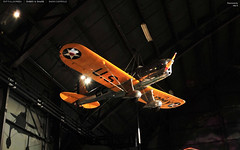 A military version of the civilian Ryan STA, the Ryan YPT-16 became the first monoplane acquired by the U.S. Army Air Corps as a primary trainer. The YPT-16 had a metal fuselage and wooden wing spars with fabric covering and external wire bracing.
A military version of the civilian Ryan STA, the Ryan YPT-16 became the first monoplane acquired by the U.S. Army Air Corps as a primary trainer. The YPT-16 had a metal fuselage and wooden wing spars with fabric covering and external wire bracing.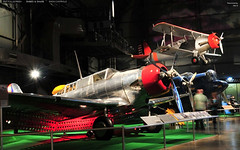 In this screen capture three airplanes can be seen, which have already been mentioned in earlier posts: the Northrop A-17A, the last of the pre-World War II single-engine attack aircraft, the Martin B-10, the first "modern" all-metal monoplane bomber produced in quantity, and the Douglas O-38F, one of the Army Air Corps' best known and most versatile airplanes during the 1930s, which was mostly used as observation aircraft.
In this screen capture three airplanes can be seen, which have already been mentioned in earlier posts: the Northrop A-17A, the last of the pre-World War II single-engine attack aircraft, the Martin B-10, the first "modern" all-metal monoplane bomber produced in quantity, and the Douglas O-38F, one of the Army Air Corps' best known and most versatile airplanes during the 1930s, which was mostly used as observation aircraft. In 1940 the U.S. Army Air Corps ordered 203 Curtiss O-52 Owls for observation duties -- signified by the designation "O" -- and used them for military maneuvers within the continental United States. Upon America's entry into World War II, however, the U.S. Army Air Forces realized that the airplane lacked the performance necessary for combat operations overseas. As a result, the Army relegated the O-52 to stateside courier duties and short-range submarine patrols off the coasts of the United States.
In 1940 the U.S. Army Air Corps ordered 203 Curtiss O-52 Owls for observation duties -- signified by the designation "O" -- and used them for military maneuvers within the continental United States. Upon America's entry into World War II, however, the U.S. Army Air Forces realized that the airplane lacked the performance necessary for combat operations overseas. As a result, the Army relegated the O-52 to stateside courier duties and short-range submarine patrols off the coasts of the United States.

No comments:
Post a Comment